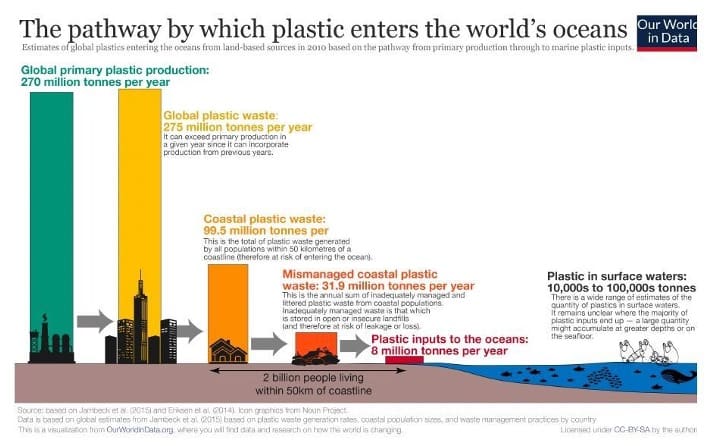Innovative Ocean Engineering is Vital for a Sustainable Future
Ocean engineering is at the forefront of sustainable solutions for some of the most pressing environmental challenges. Innovative techniques are helping to reduce emissions as well as safeguarding oceans and waterways.
NOTE: The views expressed here are solely those of the author and/or interview subject and do not represent positions of IEEE. Some references may require subscription to access content.
 By harnessing renewable energy, capturing and storing carbon, addressing ocean acidification, and battling plastic pollution, innovative engineering techniques are not only helping to reduce carbon emissions but also safeguarding oceans and other water systems.
By harnessing renewable energy, capturing and storing carbon, addressing ocean acidification, and battling plastic pollution, innovative engineering techniques are not only helping to reduce carbon emissions but also safeguarding oceans and other water systems.
Christopher Whitt is an active IEEE member with a passion and commitment to climate action. Whitt says that the ocean is under-recognized for its importance in managing the global climate system. According to the United Nations, oceans generate 50% of the Earth’s oxygen, absorb 25% of all carbon dioxide emissions, and capture 90% of the excess heat generated by these emissions [1]. “As more carbon dioxide is absorbed in the ocean, the pH decreases, making it more acidic, which is harmful to marine life and coral reefs. The only way to reverse this impact is to reduce the amount of carbon dioxide in the atmosphere,” says Whitt, the current president of IEEE Ocean Engineering Society.

Plastic pollution is a growing environmental problem with consequences for marine life and ecosystems. Ocean engineers are exploring innovative technologies and approaches to address this issue. While the vastness of the ocean makes complete removal of plastic practically impossible, several strategies are emerging. Remote sensing, using satellite imagery combined with advanced modeling, helps pinpoint areas of plastic concentration [8]. These techniques help to prevent plastic from entering the ocean in the first place. |
A leading area of ocean engineering is working to harness wind energy as a renewable source. For example, in their paper “Fault-Tolerant Control of Floating Wind Turbine With Switched Adaptive Sliding Mode Controller [2]” published in IEEE Transactions on Automation Science and Engineering, the authors propose an adaptive switched sliding mode controller to enhance the performance of floating wind turbine systems. Whitt remarks that “offshore wind is mature and the scale-up of wind power is a huge economic and employment opportunity. Wind is going to be a key component of decarbonizing our electric infrastructure. Other interesting possibilities: in-situ power generation from solar [3], thermal gradients [4], or tides and wave motion [5]. All of these are slightly less technically mature in offshore areas and will likely play more specialized roles, but there is still a huge need for innovation and development in each.”
Ocean engineering extends to understanding the capture and storage of carbon dioxide from the atmosphere and sequestering it underground. Ocean acidification, stemming from increased carbon dioxide absorption by the oceans, is a pressing issue. Ocean engineers are contributing to strategies for monitoring and mitigating its effects [6].
“Three major technology pathways hold promise in the field of carbon sequestration: biological, alkalinity enhancement, and electrochemical carbon dioxide removal (CDR),” says Whitt. “Alkalinity enhancement focuses on using low- or no-carbon energy and chemical inputs to increase the ocean’s alkalinity, thus reducing carbon dioxide levels. Electrochemical methods use chemistry laboratory equipment to extract acidic fluids from seawater, thereby reducing dissolved carbon dioxide.”
Of these, electrochemical technology appears to be the most technically mature. The chemical pathway involves processing byproducts or residues, such as waste from mining operations, near a body of water, effectively neutralizing emissions. The dynamic nature of water bodies makes measurement complex, given that chemical processes can span weeks or even months. Demonstrations of both technologies are currently underway.
The biological pathway entails the cultivation of more seaweed or similar and then sinking it into the deep ocean to prevent it from re-entering the biological carbon cycle; essentially, enhancing the natural seaweed growth process. For example, a fully automated facility can be situated in the ocean, hundreds of kilometers offshore, cultivating a vast quantity of organic material with the goal of harvesting it and sinking it to depths ranging from 1,000 to 4,000 meters below the surface, while ensuring these materials remain intact and resistant to decomposition or drifting away [7].
“The IEEE Ocean Engineering Society is unique among IEEE Societies in that its fields of interest cover a physical domain rather than a technology one,” says Whitt. As a result, the Society includes interests in robotics, signal processing, and communications and power and energy. “Our work encompasses a wide spectrum of IEEE technologies, integrating sensors in marine environments, satellite and remote sensing capabilities, robotics and automation, as well as the deployment of gliders and vessels to capture measurements. We then employ large-scale modeling techniques empowered by machine learning and artificial intelligence (AI) to estimate parameters across extensive geographical areas. Carbon dioxide removal (CDR) technologies present an exceptional opportunity for IEEE members to leverage their expertise and contribute meaningfully to our shared mission,” he says.
[1] United Nations (2023). The ocean – the world’s greatest ally against climate change. [online] United Nations. Available at: https://www.un.org/en/climatechange/science/climate-issues/ocean#:~:text=The%20ocean%20generates%2050%20percent.
[2] Z. Song, J. Liu, Y. Liu, Y. Hu and F. Fang, “Fault-Tolerant Control of Floating Wind Turbine With Switched Adaptive Sliding Mode Controller,” in IEEE Transactions on Automation Science and Engineering, doi: 10.1109/TASE.2023.3283962.
[3] G. Leir-Taha, A. Bilton and A. Marouchos, “Ocean Current Energy Conversion for Powering Distributed Sensors,” OCEANS 2021: San Diego – Porto, San Diego, CA, USA, 2021, pp. 1-5, doi: 10.23919/OCEANS44145.2021.9705722.
[4] A. Paz and H. F. Villatoro-Flores, “Technology Replacement Analysis from Fossil Fuels to Ocean Thermal Energy in a 24 MW power plant in La Ceiba, Honduras,” 2022 IEEE Central America and Panama Student Conference (CONESCAPAN), San Salvador, El Salvador, 2022, pp. 1-6, doi: 10.1109/CONESCAPAN56456.2022.9959540.
[5] A. Arakaki, “Harnessing the SHM of ocean waves,” OCEANS 2009, Biloxi, MS, USA, 2009, pp. 1-5, doi: 10.23919/OCEANS.2009.5422225.
[6] G. K V, N. K. M and M. V. Ramesh, “IoT based Ocean Acidification monitoring system with ML based Edge Analytics,” 2022 4th International Conference on Inventive Research in Computing Applications (ICIRCA), Coimbatore, India, 2022, pp. 345-353, doi: 10.1109/ICIRCA54612.2022.9985728.
[7] K. Ouchi, M. Kurahashi, M. Shibuya, S. Tabeteta and K. Iseki, “The real sea experiment of seaweed growing with DOW,” 2016 Techno-Ocean (Techno-Ocean), Kobe, Japan, 2016, pp. 235-238, doi: 10.1109 look/Techno-Ocean.2016.7890652.
[8] J. King, D. Pascual, M. P. Clarizia and P. de Maagt, “Can GNSS-Reflectometry Support Global Monitoring of Floating Matter in the Ocean?,” 2021 IEEE International Geoscience and Remote Sensing Symposium IGARSS, Brussels, Belgium, 2021, pp. 7520-7521, doi: 10.1109/IGARSS47720.2021.9553736.


